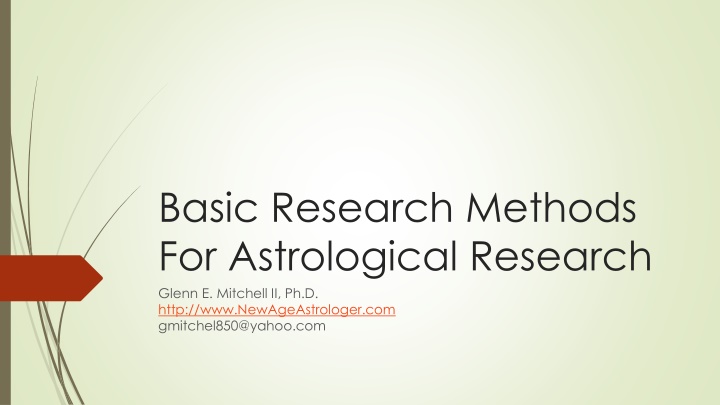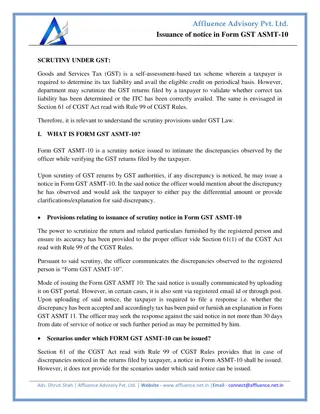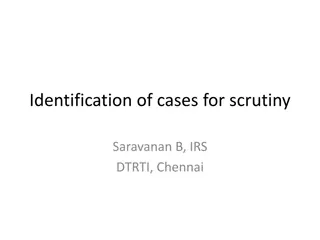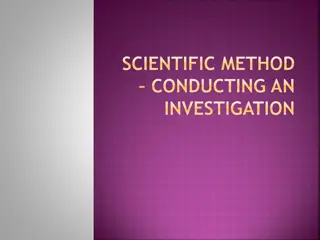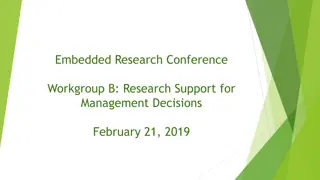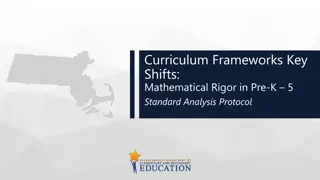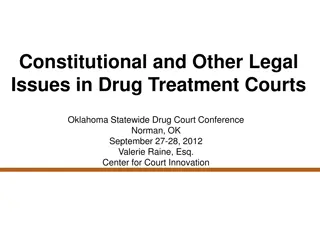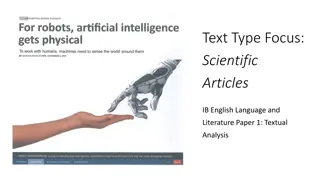Unveiling the Rigor of Astrological Research and Scientific Scrutiny
Exploring the complex world of astrological research through a comprehensive guide by Glenn E. Mitchell II, Ph.D. Understanding the controversy, challenges, and significance of astrological research, emphasizing the required rigor and scientific methodology. Delve into the essence of science, scientific explanations, and the quest for reliable knowledge. Prepare to navigate the scrutiny and promote your research effectively within and beyond the astrology community.
Download Presentation

Please find below an Image/Link to download the presentation.
The content on the website is provided AS IS for your information and personal use only. It may not be sold, licensed, or shared on other websites without obtaining consent from the author.If you encounter any issues during the download, it is possible that the publisher has removed the file from their server.
You are allowed to download the files provided on this website for personal or commercial use, subject to the condition that they are used lawfully. All files are the property of their respective owners.
The content on the website is provided AS IS for your information and personal use only. It may not be sold, licensed, or shared on other websites without obtaining consent from the author.
E N D
Presentation Transcript
Basic Research Methods For Astrological Research Glenn E. Mitchell II, Ph.D. http://www.NewAgeAstrologer.com gmitchel850@yahoo.com
So, You Want to Do Astrological Research? Astrological Research is Controversial Controversial with Astrologers Controversial with Non-Astrologers Astrology is Data-Rich . . . . . . Astrology is Data-Poor Astrological Research is Time-Consuming Rigor is required, to do the job properly. So . . . Why do astrological research?
So, You Want to Do Astrological Research? Because we have something to prove and we want our claims to be defensible. Some rigor in any endeavor is worthwhile. Proof, Defensible These involve ruling out alternative explanations. We can acquire reliable knowledge about aspects of astrology. If we do our job proper and well, all that remains is our explanation of the facts. This is the end goal of astrological research. The presence of A results in the presence of B. The Gauquelin Mars Effect The position of the planet Mars relative to the horizon at time and place of birth is correlated with athletic eminence.
Scientific Scrutiny The work of Michel and Francoise Gauquelin The most famous example of astrological research. Astrologers still gesture at it as an example of what can be achieved with astrological research. Non-astrologers also gesture at it. Only, not so politely. You can expect similar treatment, if you dare to promote your work outside of the astrology community. This presentation will help you prepare for the challenge. It will help you bullet-proof your research.
What Is Science? Unfortunately, science cannot be easily defined. Scientists, laypeople, journalists, and policymakers all define science differently. The difficulty in defining science comes mainly from confusing the content of science with the methodology of science. Science is not any general or particular body of knowledge. Much of the content of science is constantly changing. Science is distinct because of its methodology. We re going to focus on the methodology of science in this discussion. The ultimate goal of science is to produce an accumulating body of reliable knowledge. This is what we want.
Scientific Explanations Reasoning is the process of using existing knowledge to draw conclusions, make predictions, or construct explanations. Three methods of reasoning are the deductive, inductive, and abductive approaches.
Scientific Explanations Deductive Explanations Deductive reasoning starts with the assertion of a general rule It proceeds from there to a guaranteed specific conclusion. Deductive reasoning moves from the general rule to the specific application: In deductive reasoning, if the original assertions are true, then the conclusion must also be true, if the form of the argument is valid. Rely on the rules of formal logic. The word formal in scientific discourse, such as formal modeling, refers to formal logic. Ex. The Law of Gravity If all objects exercise a mutual attraction to one another, then all objects are bound to fall toward the Earth when released.
Scientific Explanations Inductive Explanations Not all scientific explanations are based on laws of universal form. That s a good thing for astrologers, because we have few, if any, universal generalizations. What can be suggested is that there is a high probability that individuals born with Mars at a certain position on the horizon are likely to excel at athletics. The so-called Gauquelin-effect. Inductive reasoning begins with observations that are specific and limited in scope It proceeds to a generalized conclusion that is likely, but not certain, in light of accumulated evidence. You could say that inductive reasoning moves from the specific to the general. Much scientific research is carried out by the inductive method: gathering evidence, seeking patterns, and forming a hypothesis or theory to explain what is seen. Conclusions reached by the inductive method are not logical necessities No amount of inductive evidence guarantees the conclusion. This is because there is no way to know that all the possible evidence has been gathered and that there exists no further bit of unobserved evidence that might invalidate the hypothesis.
Scientific Explanations Abductive Reasoning Take your best shot with the data at hand. Abductive reasoning typically begins with an incomplete set of observations and proceeds to the likeliest possible explanation for the set. Abductive reasoning yields the kind of daily decision-making that does its best with the information at hand, which often is incomplete. A medical diagnosis is an application of abductive reasoning: given this set of symptoms, what is the diagnosis that would best explain most of them? Likewise, when jurors hear evidence in a criminal case, they make their best guess based on what they know from the case at hand. The abductive process can be creative, intuitive, even revolutionary. Einstein s thought experiments were neither wholly deductive, nor inductive.
Quantitative vs. Qualitative Data Will Morris, Ph.D. will follow this presentation with a detailed discussion of qualitative research in astrology Quantity vs. Quality The typical distinction is this . . . . . . Quantitative data can be measured numerically and qualitative data cannot. It s more complicated than this. An example would be the color of the sky. Color is generally considered a quality. A colorimeter can measure the color of the sky quantitatively. We often convert qualities into quantities. The presence/absence of a quality can be quantified. It s common to call these dummy variables and code them 1 = yes and 0 = no.
Quantitative vs. Qualitative Data As a statistical research methodologist, I deal with both quantitative and qualitative data. My primary focus is on quantitative methods and techniques. For this presentation, that will be our exclusive focus. We re going to focus even more narrowly. We re going to talk a lot about statistical analysis. If you re number phobic, fear not. I ll spare you the math. We ll talk at the conceptual level in this presentation.
Concepts One of the most significant symbols in language, especially as it relates to research, is the concept. Science begins by forming concepts to describe the empirical world. A concept is an abstraction representing an object, or a certain phenomenon, such as aggression. Concepts serve a number of functions in research First and foremost, they are the foundation for communication Without agreed-upon concepts, intersubjective communication is impossible. Second, concepts introduce a perspective. Third, concepts are a means for classification and generalization Fourth, concepts serve as components of theories and thus of explanations and predictions.
Definitions If concepts are to serve as functions of communication, sensitization of experience, generalization, and theory construction, they have to be clear, precise, and agreed-upon. Concepts such as aggression mean different things to different people and are used in different contexts to mean different things. Any scientific discipline is concerned with its vocabulary. Two types of definitions are important in scientific work: conceptual and operational.
Definitions Conceptual Definitions Definitions that describe concepts using other concepts. What is a good conceptual definition for aggression? Conceptual definitions that enhance communication share the following: Point out unique attributes or qualities; Should not be circular; Should be stated positively; Should use clear terms.
Definitions Operational Definitions Often the empirical attributes that are represented by concepts cannot be observed directly. An example is the concept of power. Empirical existence of the concept has to be inferred. Inferences of this kind are made with operational definitions. An operational definition is a set of procedures that describe the activities to perform to establish empirically the existence or degree of existence of phenomena described by a concept. Operational definitions tell us what to do and what to observer.
Definitions Ex. The Effect of Self Assertion Each planet conjunct Mars with an orb of 8 degrees gets 12 or fewer points Each planet conjunct ASC with an orb of 8 degrees gets 12 or fewer points Each planet conjunct ASC ruler with an orb of 8 degrees gets 12 or fewer points Each planet conjunct the Anti-Vertex with a 3 degree orb gets 8 or fewer points Each planet conjunct the East Point with a 3 degree orb gets 8 or fewer points Each planet in the 1sthouse gets 10 points Each planet within 2 degrees of the first house but in the second house get 3 points. Each planet parallel Mars with a 1 degree orb gets 2 points Each planet parallel ASC with a 1 degree orb gets 2 points Each planet parallel ASC ruler with a 1 degree orb gets 2 points Each planet parallel the Anti-Vertex with a 1 degree orb gets 2 points Each planet parallel the East Point with a 1 degree orb gets 2 points
Relationships Scientific explanations relate phenomena to be explained (dependent variables) to other explanatory phenomena (independent variables). A relation in scientific research always means a relationship between two or more variables. When we say that variable Y and X are related, we mean there is something common to both variables. Kinds of relations Direct (or positive) Inverse (or negative)
Relationships We can measure the strength of a relationship Measures of Association Chi-square statistic is frequently used with categorical data. Correlation is used with interval-level data.
Astro Databank Fair to say, it s the largest single repository of natal chart data for research. By the standards of astrological research, it s a huge resource. Tens of thousands of birth records for notable persons Many/Most with birth times. Quality of birth data is rated. Categorized. Submitted by volunteers. There are problems with it. We ll talk about them in greater detail during this presentation. Probably the biggest challenge to using the Astro Databank is the format of the raw data. You need to be a proficient XML programmer. Fortunately, some astrological software is including all or part of it.
The Meaning of Statistics Let s get this definition out of the way. Statistics does not equal quantitative. One can work with numbers and not use statistics. Statistics involves drawing an inference about an unmeasured population directly from a sample. Ex. The percentage of people with a T-Square in their horoscopes. We pull out all of the people with a T-Square from the AstroDatabank. Get their percentage of all of the entries in the AstroDatabank. That s a statistic. It s a sample characteristic. We don t know what percentage of the world s population has a T-Square in their natal charts. A population characteristic is called a parameter. We use the sample statistic as an educated guess about the population parameter. One with a mathematical foundation.
Sampling Frame In statistics, a sampling frame is the source material from which a sample is drawn. It is a list of all of the elements that can be sampled. I mention sampling frames because it is quite common in astrological research to equate the AstroDatabank charts with all individuals. That s not quite right. The AstroDatabank data is a sample of so-called notable persons. It is not a sample of everybody. The sampling frame is critical, because we can only draw statistical inferences from the sample to the population sampled. With the AstroDatabank data, we only know about notable persons. Ordinary folk are not included.
Convenience Sample The fundamental sample in statistics is the Simple Random Sample (SRS) We get a list of the entire population We select at random, elements to be sampled. We know the mathematics of the simple random sample well. Stated differently, we know the sampling distribution for the simple random sample. The AstroDatabank data is not a simple random sample. It is a form of convenience sampling. A convenience sample is a non-probability sample. It is made up of elements that are easy to obtain. With a probability sample, every population element has a known, non-zero probability of being selected. The problem is, we have no way to go in terms of mathematical probability from a convenience sample to a larger population.
Sampling Error In statistics, sampling error is the error caused by observing a sample instead of the whole population. The sampling error is the difference between a sample statistic used to estimate a population parameter and the actual but unknown value of the parameter. With a simple random sample, the sampling error decreases as the sample gets larger. We know well the mathematics for the distribution of sampling errors with a simple random sample.
Validity, Reliability, Generalizability Laymen tend to use these terms interchangeably. Validity and Reliability are different forms of measurement error. Generalizability is whether we can make an inference from a sample to a larger population. We cannot generalize on the basis of statistical theory from a convenience sample to a larger population. Validity concerns whether we have measured what we really set out to measure. Or, have we measured something else by mistake? Reliability concerns the idea of repeated measurements. Do we get the same answer each time.
Validity, Reliability, Generalizability There are issues of validity and reliability with the Astro Databank data. First, no dataset is perfect. Measurement error is something we strive to eliminate but cannot achieve. Validity issue Who exactly is a Notable? Did the volunteer get the right birth date, birth time, and birth location? IOW, did the volunteer actually measure the birth details for the notable in question? Reliability We all know the issue of unreliable birth times. Get the birth time wrong by approx. 4 minutes, the Ascendant is off by approx. 1 degree. There are multiple submissions for some notables. Which are the correct birth details to use.
Exploratory Data Analysis Exploratory Data Analysis (EDA) An approach/philosophy It is precisely that. An approach. Not a set of techniques. EDA postpones forming hypotheses. It allows the data itself to reveal its underlying structure and model. EDA can be used to generate hypotheses and from them, theories.
Theories and Hypotheses A lot of astrological research is atheoretical. A theory tells a story. We expect the position of Mars on the horizon at birth to determine the degree of athletic excellence an individual will display. Why? Quantitative research proceeds from theories to testable hypotheses to data collection to tests of the hypotheses to reporting the results. A lot of astrological research foregoes theory. It takes a whole bunch of variables, throws them into a piece of research software, and regurgitates the results. What s the problem?
Proving Causation Correlation alone does not establish causation. It is a necessary condition. It is not a sufficient condition. To prove causation We need association (e.g. correlation) We need time order If a change in A causes B to change, then A needs to change before B. We need a theory Non-spurious relationship In a spurious relationship, a false correlation between two variables caused by a third variable exists. Ex. Mass shootings are almost non-existent with the Sun in houses 1-VI. This is an artifact that most mass shootings occur at work, churches, and public gatherings AND almost always during the day.
Sources for Theories Reviews of the Existing Literature Exploratory Data Analysis (EDA) Deduction
Hypotheses A hypothesis is the tentative answer to a research problem expressed in the form of a relationship between dependent and independent variables. They are tentative because they can only be verified after being tested empirically. Research hypothesis share four characteristics Clear Value-free Specific Amenable to empirical testing
Statistical Hypothesis Testing A statistical hypothesis is an assumption about a population parameter. This assumption may or may not be true. This assumption is testable. Hypothesis testing refers to the formal procedures used by statisticians to accept or reject statistical hypotheses. Commonly, in astrological research, a data set obtained by sampling is compared against a synthetic data set, called a control group. Control group is borrowed from experimental design. In experimental design, the treatment group receives the treatment. The control group does not. The results for both groups are then compared.
Random Control Group Birth charts with random data. Simplest example is using random dates of birth. More sophisticated control groups are possible. Even distribution within a time interval Randomized time of birth Randomized place of birth Even distribution within a geographic area, like the United States. With my research into Mass Shooting Events (MSEs), I used JigSaw from Esoteric Technologies for drawing my control group. I limited the control group to the time interval of my data and to longitudes and latitudes for the United States. I then analyzed the data in Alphee Lavoie s AstroInvestigator software.
Random Control Group Synthetic random data works well for event data, like my project on Mass Shooting Events. The idea is that you are comparing event dates/time/places against random dates/events/places. When you have individual birth charts in your data file, you could consider drawing at random from a set of birth charts like the Astro Databank. The idea is that you are comparing natal charts for your study group against a set of random natal charts for real individuals. Again, you could restrict the random birth charts from a source like the Astro Databank to specific time intervals and geographic locations, so the control group is a similar sample.
Statistical Hypothesis Testing Steps Formulate Null and Alternative Hypotheses Null Hypothesis Default position There is no relationship between two phenomena Any observed relationship is owing to chance. Alternative Hypothesis The observed relationship is the result of some non-random cause.
Statistical Hypothesis Testing Steps Choose the Level of Significance The significance level for a study, , is the probability of the study rejecting the null hypothesis, given that it was true. Ex. A significance level of 0.05 indicates a 5% risk of concluding that a difference exists, when there is no actual difference. The p-value of a result, p, is the probability of obtaining a result at least as extreme, given that the null hypothesis was true. Find the Critical Values The boundary between the acceptance region and the rejection region in the testing of a hypothesis. Stated differently, it s the value of the test statistic beyond which we reject the null hypothesis. Choose the Appropriate Test Statistic Report Your Conclusions
Choosing a Test Statistic The type of quantitative data plays a big role in determining the available test statistics.
Types of Quantitative Data Continuous and Discrete Continuous Does not have a minimum-sized unit. Ex. Declination. We could get down to a minute fraction of a second of a minute of a degree. Discrete Does have a minimum-sized unit. A variable that cannot be further subdivided is discrete. Ex. Astrological sign.
Types of Quantitative Data Categorical Data Data that can be organized into mutually exclusive categories. Often, no sense of order Ex. Sign of Planet, House of Planet Ordinal Data Data that can be sort ordered (more/less of something). Cannot say how much more/less Ex. Orb of an aspect Interval Data Data can be sorted and we can say how much more/less. Ex. Declination of a planet Ratio Data Data can be sorted, we can talk about more/fewer units, and we can talk about twice as much, three times as much, etc. Data has a natural zero point. Ex. Velocity of a Planet
Types of Quantitative Data We can do more sophisticated analyses as we move from categorical, to ordinal, to interval, to ratio data. We can do statistical analysis with all four types of data, but the techniques differ. We can always move down the hierarchy. Ex. We can treat interval data like it is ordinal or categorical data. We can move up the scale by making dummy variables. Ex. Gender can be recoded as Female yes=1 and no = 0. A dichotomy (1/0) is interval in nature. Astrology research software varies in the techniques they offer.
Available Test Statistics Categorical Data Measurements: counts and percentages, plots and graphs Ex. Esoteric Technologies JigSaw application. Test Statistics: A One Sample Chi-Square test is most common in astrology software. It looks at one categorical variable with one set of cases. Ex. Alphee Lavoie s AstroInvestigator application. Ordinal Data Paired t-tests Ex. David Cochrane s Sirius application performs t-tests. It also prepares data for statistical software, where more sophisticated analysis, like multiple linear regression can be applied. Interval Data Measurements: levels, averages, variation, counts, percentages Test Statistics: correlations, regression, ANOVA (Analysis Of Variance), Factor Analysis
Content Analysis Content analysis is a method of data analysis as well as a method of observation. Content analysis is generally applied to messages in speeches, documents, etc. It can also be applied to astrological research, if we consider the keywords associated with planets, signs, houses, aspects, and midpoints as messages from the universe. Objectivity in this context involves analysis carried out on the basis of the explicit rules that enable researchers to obtain the same results. Ex. I used a set of theory-driven, astrological keywords related to Mass Shooting Events (MSEs) derived from Alfred Witte and Hermann Lefeldt s Rules for Planetary Pictures: The Astrology of Tomorrow. One application is the analysis of Keyword Frequencies. Quantitative methods can be applied Synthesis
Reporting Research Abstract Statement of the Research Question Literature Review Theory and Hypotheses Data Discussion Sources Operationalization Methods Applied Results Summary Citations
Where to Publish? NCGR Journal Correlation: The Journal of Research into Astrology Astrological Association of Great Britain AFA Annual Research Journal Sites for ISAR, AFAN, OPA Self-Publish
Future Kepler Conferences The Kepler Conference is becoming more rigorous in its expectations for future research presentations. There is an expectation that the research be theoretically-grounded, with a thorough literature review. Hypotheses should be explicitly described. Preliminary results from exploratory data analysis are acceptable, but should include a discussion of the theory and specific hypotheses generated.
Practice Session Imagine there was no Gauquelin study. We want to study the effect of Mars on eminent athletics in a pilot study. Let s walk through a research design. What would our operational definition for Mars effect look like? What would out operational definition for eminent athletes look like? Where would we get an exhaustive list of eminent athletes? Complete with birth date, time, and place?
